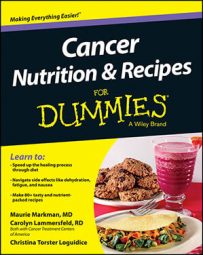Smoothies can be a great weapon in your cancer-fighting arsenal, whether you’re fighting fatigue, you have a sore mouth or throat, you’re struggling with an upset stomach, or you’re experiencing cancer-related weight loss.
Whatever your need, you can customize your smoothie to suit it. For example, if you’re dealing with unintentional weight loss, you can make your smoothies higher in calories and protein by adding nut butters (such as peanut butter or almond butter), and if you have a sore mouth, creamy, milk-based smoothies can be soothing going down.
Even if you’re not struggling with any cancer- or treatment-related side effects, you can make a smoothie when you want a quick meal or snack or just want to get a quick dose of highly digestible nutrients. Because smoothies are liquids, they’re also hydrating, and when you’re undergoing treatment, fluids are especially crucial because they can help to flush out the byproducts of chemotherapy and keep you hydrated to ward off dehydration.
To make a smoothie, you’ll need something solid to thicken the mixture (like ice or frozen fruit), something liquid to make it drinkable (like juice, milk, or milk substitute), and something to bind these two types of ingredients together (like fruits or veggies) when you blend them up. The more frozen ingredients or high-fiber ingredients you add to the mix, the thicker the smoothie will be.
You’ll also need to consider the water content of the fruits you’re using. Watermelon, for instance, will have very little texture once pureed, so it’s best thought of as a liquid for smoothie-making purposes.
There are countless ingredients and combinations that can be used when making smoothies. Experimenting is part of the fun. See the following table for some ingredient ideas to get you started.
| Liquid Base Options | Fruit Options (Frozen, Fresh, or Dried) | Vegetable Options | Additional Blend-Ins |
|---|---|---|---|
| Milk | Bananas | Carrots | Hemp, soy, or whey, protein powder |
| Milk substitute (like almond, rice, or soy milk) | Apples | Greens | Natural sweetener (like agave nectar, blackstrap molasses, honey, molasses, pure maple syrup, or stevia) |
| Fruit juice | Pears | Cucumbers | Silken tofu or tofu |
| Carrot juice | Citrus fruits | Avocados | Kefir or yogurt |
| Unsweetened tea (like herbal or green) | Stone fruits (like cherries, peaches, or plums) | Ginger root | Spices and seasonings (like cinnamon or vanilla) |
| Coconut water | Berries | Herbs and botanicals (like parsley or wheatgrass) | Nuts and nut butters (like almond, hazelnut, or peanut) |
| Vegetable juice | Melons | Flaxseed oil, flaxseeds, or chia seeds | |
| Tropical fruits (like coconut, mango, papaya, or pineapple) | Tahini (sesame seed butter) |

